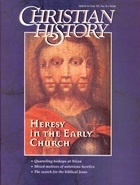To some, early church debates about Christ read like a computer programming language: impossible to decode. To others, the early church theology seems as relevant as the dress codes of a Carthusian monastery.
To help us understand what the early church was driving at in the millions of theological words it produced, Christian History talked with Thomas Oden, who teaches theology at Drew University. He is author of the three-volume systematic theology: The Living God, The Word of Life, and Life in the Spirit (Harper San Francisco, 1992).
Christian History: Why did the early church spend so much energy trying to understand precisely how Jesus was human and divine, especially since ultimately it’s a mystery how he is both?
Thomas Oden: All ancient Christian writers and councils knew that it’s impossible to fathom fully the Incarnation. Attempts to articulate this mystery always fall short of absolute precision. On the other hand, they discovered that you can talk about the Incarnation in ways that fail to do justice to what we do know.
The early church had to deal with the apostolic testimony of the New Testament, and the New Testament clearly portrays Jesus as the Savior, as Mediator between God’s holiness and human sin. It portrays him as truly God and truly human. Any teaching that failed to do justice to the full witness of the Scriptures had to be challenged.
For example, Arianism failed to understand that in Jesus we meet the Uncreated One. Arius thought Jesus was a creature. That runs counter to the apostolic testimony, particularly in John’s and Paul’s writings. Theological definitions are precise because they look for language that rules out heretical interpretations—interpretations that fall short of the wholeness of biblical faith.
If these ecumenical councils hadn’t done the hard labor of working out the precise language, we would have had, not less, but more trouble understanding Jesus Christ.
Why did many early church fathers, like Athanasius, argue for orthodoxy in ways that seem harsh, even nasty?
I don’t think Athanasius’s responses, to take that example, were simply pugnacious. He knew that more than theological opinions were at stake—nothing less than the integrity of the New Testament, the apostolic testimony to Christ. In the case of Arianism, if the church taught that Christ was somehow less than God incarnate, then it would have given the whole game away. You cannot speak about reconciliation the way the New Testament does—a reconciliation of a holy God and sinful humanity—without a full incarnation. For Athanasius, the issues were too important to discuss calmly.
Some in the early church who were branded as heretics—like the Monophysites—are today reconciling with the Orthodox Church. Are Monophysites heretics or not?
Clearly some of the more radical Monophysites were, but in some cases, the two parties agreed on fundamentals.
The Monophysites, in trying to protect the deity of Christ, asserted that Christ had one nature (monophysis) rather than two. But the word physis, or “nature,” was used differently by Monophysites and the Orthodox; in many cases, they were not disagreeing as much as talking past one another. In the last two years, the Coptic, Syrian, and other Monophysite churches have moved significantly towards reconciliation with Eastern Orthodoxy, though some serious differences still remain.
Many Protestants balk at the phrase, “Mary, the Mother of God.” Yet the early church was in near unanimous agreement on this term.
Though many Protestants have problems with the term, it seems to be a concept we all accept. Luther, Calvin, and Wesley, and the major Protestant teachers don’t reject the formula of the Council of Ephesus. They don’t think of Mary as merely the Christ-bearer, only a specially annointed man, but the actual bearer of God in the flesh.
Again, it’s a matter of faithfulness to the apostolic witness. Jesus is the pre-existent Logos, who, John’s Gospel says, is with God from the beginning. If this same One is born in the flesh, it is not someone less than God who is born—and Mary is the mother. So the term may trouble some Christians, but I don’t think the theology does. In this, Protestant, Catholic, and Orthodox agree.
The early theological formulations have been under steady attack for some time. How do you respond, for example, to those who say the early church’s conclusions about the Trinity reflect, not timeless truth, but only a Greek intellectual world view?
The thinking about the Trinity did not begin with philosophy but with the apostolic text, the Scriptures. Paul gives this benediction in 2 Corinthians 13:13: “The grace of the Lord Jesus Christ and the love of God and the fellowship of the Holy Spirit be with you all.” Embedded in this statement (written in the early 50s) is a very early oral tradition that understands God in a tri-fold way. Take another example: In Jesus’ baptism, the Father descends to bless the Son by the power of the Spirit. Trinitarian prototypes such as these do not come out of Greek philosophy.
Are you saying there is no cultural influence?
Not at all. When the apostolic teaching moved into Greek culture, it used language and symbols appropriate to that culture. But the fundamental notion of the Trinity came before the church ever discussed it in philosophical terms.
Furthermore, even when we do notice the influence of Greek culture in the development of doctrine, we have to recognize the role of the Holy Spirit. From the beginning, the Spirit has been at work to guide the church into all truth, as Jesus promised. So it’s not accidental that the Spirit has guided the church to formulate a clearer teaching about God—Father, Son, and Holy Spirit.
That doesn’t mean we have to accept everything the early church adapted from Greek culture. The church in India, for example—which arose in the early centuries and held to the basic theology formulated in Greek culture—had to proclaim the faith in something other than Greek categories!
Some moderns believe that early church doctrine is hopelessly male-centered, with talk of a Father-God bringing forth a Son. What is your view?
Actually, the early church teachers thought just the opposite. Augustine taught that God’s saving action in his Son Jesus Christ actually honors both male and female. Naturally, an incarnate savior must be born of a woman, for men cannot give birth. If he had become female, however, he would have given a double honor to the female sex—a female bringing forth a female savior. Instead, God becomes male by being born of a female, and so he honors both sexes in the Incarnation.
Others feel ancient orthodoxy is rigid. Were early creeds theological straitjackets?
Actually, a great achievement of the early orthodox consensus is its flexibility! Within this orthodoxy, there is enormous cultural flexibility. That’s why you find the Nicene Creed, for example, expressed in every language on earth, and in a variety of Christian communions. Southern Baptists, Dutch Reformed, Chinese house-church believers, Mexican Pentecostals, and Rumanian Orthodox all share the same basic Christological and Trinitarian definitions.
Has studying this abstract doctrine helped you in your own faith?
My faith has not been helped by abstract doctrine. But it has been helped by the church’s hymnody, its liturgy, its pastoral care. Above all, I’ve been helped by its exegesis, its constant wrestling with Scripture, especially with the New Testament Jesus. The ecumenical community in the first five centuries was constantly making decisions in reference to specific texts of Scripture. It always stood under the authority of Scripture.
So these theological documents, creeds, and treatises are to me lively, relational, and meaningful documents because they wrestle with Scripture and, therefore, with issues we wrestle with today.
Copyright © 1996 by the author or Christianity Today/Christian History magazine.
Click here for reprint information on Christian History.

Support Our Work
Subscribe to CT for less than $4.25/month





























